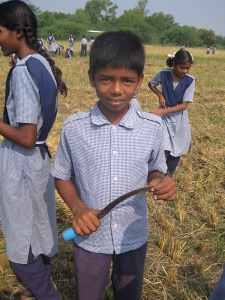Cross posted from Worldwatch Institute’s Nourishing the Planet.
 At the Rural Development Foundation’s (RDF) primary school in Kalleda, a small village in the Warangal district of Andhra Pradesh, India, students carry gardening tools, along with their notebooks and pencils.
At the Rural Development Foundation’s (RDF) primary school in Kalleda, a small village in the Warangal district of Andhra Pradesh, India, students carry gardening tools, along with their notebooks and pencils.
All of the students work in the school’s garden, cultivating and harvesting rice, lentils, corn, and cotton that is used to make the daily meals or sold to the village and to other schools. Students also take turns tending a field of marigolds and selling them in Kalleda. All of the profit goes back to the school.
And the students carry another important tool–a camera.
Cameras were provided by Bridges to Understanding (Bridges), a Seattle-based non-profit that uses digital technology to empower and connect children around the world. Students participating in the Bridges curriculum are taught to use cameras and editing software to develop stories about their community and culture. These videos, comprised of a photo slide show with a running narration, are then shared with the Bridges online community which is made up of schools in seven countries: Azerbaijan, Cambodia, Guatemala, India, Peru, South Africa, and the U.S.
For many students, it’s the first time they have ever even held a camera. “When I first asked my students if they thought they could ever design, shoot and edit their own film they just shook their heads and said, `there’s no way,” said Elizabeth Sewell, Bridges program coordinator at the RDF school in Kalleda.
But not only did her students successfully develop a concept for, shoot and edit a video about local water pollution, they are also participating in an online discussion about their school garden with another group of students at the Aki Kurose school in Seattle. Students at Aki Kurose are learning to grow corn, squash, and beans using traditional Native American practices. And they volunteer at a local food bank, a completely new concept to the students at Kalleda. “Thank you for your post about your school garden and information about your food bank,” wrote Sewell’s students. “We had never heard of a food bank before your post. We like the idea of a place where people can get free food.”
Sewell explains that having a conversation about farming with students in Seattle helps students at Kelleda “realize what makes their community unique but also that there are other kids out there dealing with similar issues, providing a model or inspiration for alternatives and creating a global sense of solidarity in facing these problems.”
And, according to Sewell, the Bridges video project gives students a concrete and achievable goal to strive towards as they grapple with larger questions about their role as “agents of change” in their community and the world.
“At first, the prospect of designing, shooting and editing a movie seems insurmountable but then they produce these beautiful films,” says Sewell. “And then you knock down that barrier, you show them what they are capable of doing. And then they can start to approach other, larger and more institutional, problems the same way. Suddenly, in their own eyes, there are no limits to what they can achieve.”
To read more about the use of storytelling and digital technology to connect and educate farmers, see: Acting it out for Advocacy and Messages from One Rice Farmer to Another.
Thank you for reading! If you enjoy our diary every day we invite you to get involved:
- Comment on our daily posts-we check comments everyday and look forward to a regular ongoing discussion with you.
- Receive weekly updates-Sign up for our “Nourishing the Planet” weekly newsletter at the blog by clicking here and receive regular blog and travel updates.


